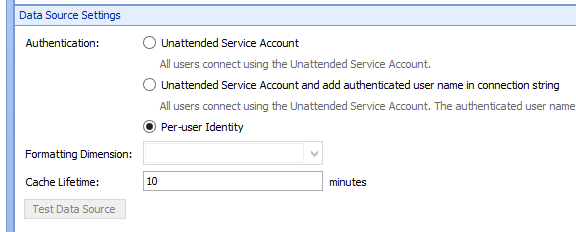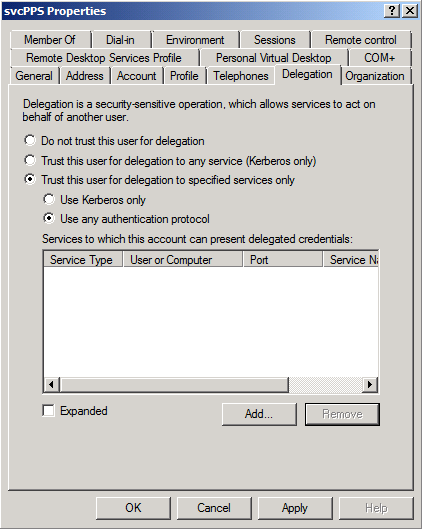Hinweis
Für den Zugriff auf diese Seite ist eine Autorisierung erforderlich. Sie können versuchen, sich anzumelden oder das Verzeichnis zu wechseln.
Für den Zugriff auf diese Seite ist eine Autorisierung erforderlich. Sie können versuchen, das Verzeichnis zu wechseln.
Issue
There are a number of different types of data sources that we can create in PerformancePoint Services Dashboard Designer, and a number of different ways of creating them.
This article describes a way in which we can create a new Analysis Services data source in Dashboard Designer using per-user identity, and some steps for setting up the Kerberos constrained delegation that is required in order for it to work.
These are general steps for a typical environment, but they work well in the majority of cases.
Part 1 – Gather the information
Here is some sample environment information.
- The account that is running PerformancePoint Services Application Pool is: svcPPS
- The name of the SharePoint Server where PerformancePoint Services is running is: APP01
- The account that is running the Claims-To-Windows-Token-Service is: svcClaims
- The name of the SharePoint Server where the Claims-To-Windows-Token-Service is running is: APP01
- The account that is running the Analysis Services instance that we are making the new data source connection to using per-user identity is: svcSSAS
- The name of the Analysis Services server that we are making the new data source connection to using per-user identity is: SSAS01
- The FQDN naming for domain objects is: contoso.com
Part 2 – Set the SPNs in Active Directory
Based on our environment information above, below are the SPNs that we need set in Active Directory.
- NOTE 1: You will need to do these at a PowerShell command prompt on a Domain Controller.
- NOTE 2: Copy and paste sometimes does not work with these, so you may need to type them in manually.
- NOTE 3: The first 2 SPNs below are not valid SPNs. They are applied to the specified service accounts in order to reveal the delegation options in the AD users and computers add-in.
- NOTE 4: Using -s rather than -a will check for duplicate SPNs before adding that SPN.
- setspn - a PPS/APP01 svcPPS
- setspn - a CTWTS/APP01 svcClaims
- setspn - a MSOLAPSVC.3/SSAS01 svcSSAS
- setspn - a MSOLAPSVC.3/SSAS01 .contoso.com svcSSAS
Part 3: – Configure constrained delegation
Once the SPNs have been added in Active Directory, then we will need to configure constrained delegation for the PerformancePoint Services account, and for the Claims-To-Windows-Token-Service account.
Below are general steps for doing that.
- In Active Directory Users and Computers > svcPPS > Properties > Delegation Tab > Trust this user for delegation to specified services only > Use any authentication protocol > Add > Users or Computers > svcSSAS > Check Names > OK > “Select All” Available Services > OK > OK.
- In Active Directory Users and Computers > svcClaims > Properties > Delegation Tab > Trust this user for delegation to specified services only > Use any authentication protocol > Add > Users or Computers > svcSSAS > Check Names > OK > “Select All” Available Services > OK > OK.
Part 4: – Make sure Claims-To-Windows-Token-Service setup is complete
Since the Claims-To-Windows-Token-Service is involved in the Kerberos constrained delegation process, the account that is running the Claims-To-Windows-Token-Service needs to have certain permissions on the SharePoint servers where the Claims-To-Windows-Token-Service is running.
Make sure that the account that is running the Claims-To-Windows-Token-Service (svcClaims in my sample environment information above) has the permissions below on ALL of the SharePoint servers where the Claims-To-Windows-Token-Service is running.
- Must be in the local Administrators group
- In the server’s local security policy (Start > Administrative Tools > Local Security Policy > Local Policies > User Rights Assignment), the Claims-To-Windows-Token-Service account needs to have these permissions:
- Act as part of the operating system
- Impersonate a client after authentication
- Log on as a service
Part 5: – Testing
After all of the steps above have been completed, there may be an Active Directory replication delay before we are able to create a new Analysis Services data source in Dashboard Designer using per-user identity, but sometimes it will start working right away. If it doesn’t start working right away, wait for a little while for Active Directory replications to happen (or force it), and then close and reopen Dashboard Designer and try it again.

